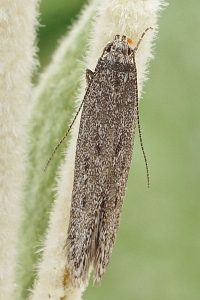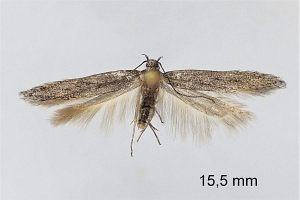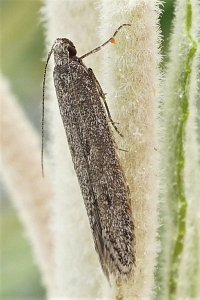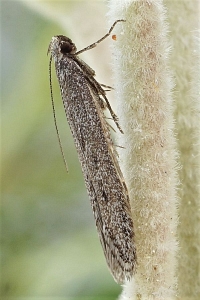

 +2Kontinente:EU
+2Kontinente:EU1. Lebendfotos
1.1. Falter
2. Diagnose
2.1. Geschlecht nicht bestimmt
3. Weitere Informationen
- Eulamprotes parahelotella Nel, 1995 [Originalkombination und bis Huemer & Karsholt (2020) übliche Kombination]
3.1. Taxonomie
Huemer & Karsholt (2020) nehmen die Neukombination mit Oxypteryx vor, schreiben aber auch, dass noch Fragen offen sind: "Oxypteryx. Eulamprotes Bradley, 1971 with the type species E. atrella is shown to be a synonym of Oxypteryx Rebel, 1911 (Bidzilya et al. 2019), resulting in a number of new nomenclatural changes. We here propose the following new combinations: [...] Oxypteryx parahelotella (Nel, 1995) comb. nov. [...] Despite this new taxonomic approach, the genus is in strong need of revision. DNA barcodes separate into three clades seemingly supported by some morphological characters. For example, species formerly considered to be in the E. wilkella-group and characterized by the blackish ground colour of the forewings with silvery or whitish markings, form a separate clade. Further, the genus has an extraordinary intraspecific barcode variation with 18 sequenced species belonging to 27 BINs, with at least three yet unidentified species."
(Autor: Erwin Rennwald)
3.2. Typenmaterial
Nel (1995: 38, 40): « Holotype mâle : Mont Ventoux, Combe du Grand Barbeirol, 670 m [Fußnote: « Station CGB, selon la terminologie de Luquet, in Bigot et al., 1990. »], 16 mars 1990, P.G. JN 2730, G. Luquet leg., piégeage lumineux, conservé au M. N. H. N., Paris.
Allotype femelle : idem, 23/25 mars 1990, P. G JN 2705, G. Luquet leg., conservé au M. N. H. N., Paris.
Paratypes : 13 mâles et 8 femelles, idem, mars-avril 1976 et 1990 (G. Luquet leg.), in collections G. Luquet (Paris) et J. Nel (La Ciotat) ; certains seront déposées au M. N. H. N., Paris. »
3.3. Literatur
- Huemer, P. (2010): Die Schmetterlingssammlung Jacques Nel (Lepidoptera) – eine bedeutende Erweiterung der Bestände des Tiroler Landesmuseums Ferdinandeum. — Wissenschaftliches Jahrbuch der Tiroler Landesmuseen 3: 152-167. [PDF auf zobodat.at]
- Huemer, P. & O. Karsholt (2020): Commented checklist of European Gelechiidae (Lepidoptera). — ZooKeys 921: 65–140. [zur Arbeit und PDF-Download auf zookeys.pensoft.net]
- Erstbeschreibung: Nel, J. (1995): Sur quelques espèces nouvelles ou peu connues de Gelechiidae observées au Mont Ventoux (Vaucluse) et en Basse-Provence. Quatrième contribution à la connaissance des Gelechiidae du sud de la France (Lepidoptera). — Alexanor 19 (1): 37-45.
- Requena, E. & J. J. P. De-Gregorio (2017): Addicions al catàleg dels gelèquids de Catalunya i les illes Balears (Lepidoptera: Gelechiidae). — Butlletí de la Societat Catalana de Lepidopterologia 108: 121-128. [PDF auf researchgate.net]







